My following day was earmarked for a visit to Hamlet. In order to do that, I had to go to the place of Helsingør. As soon as I left the train I realised and could see that the air was incredibly clean. And then, right when you leave the railway station you see the stunning Kronborg Castle.
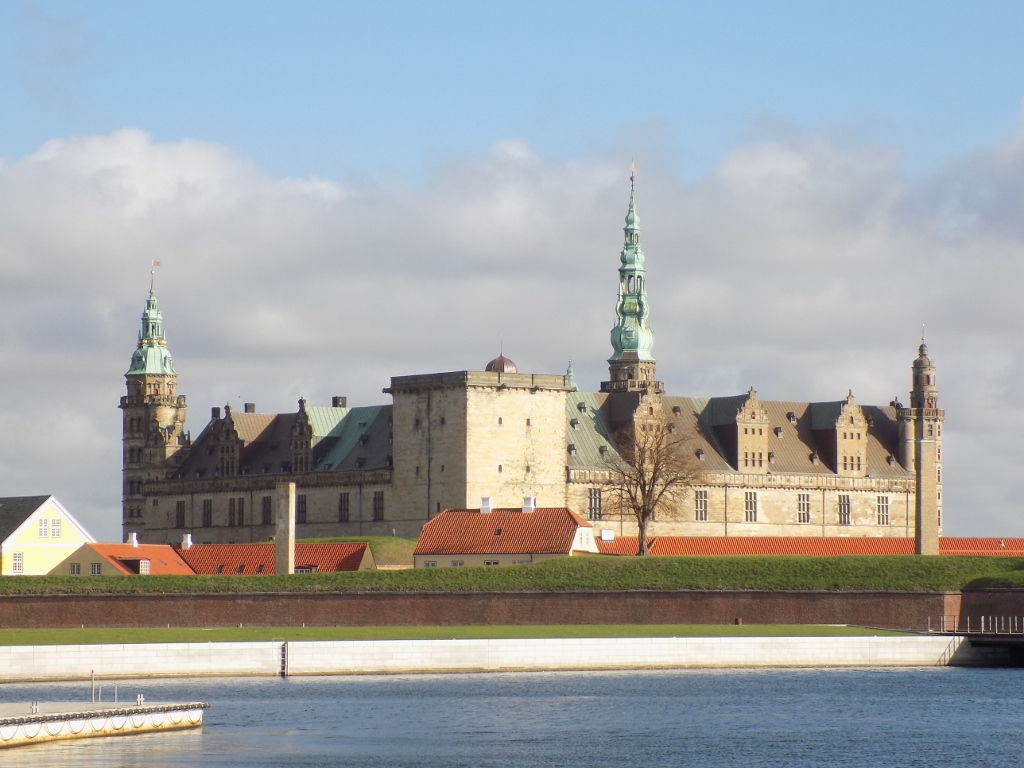 Kronborg Castle
Kronborg Castle
Still, I was particularly delighted when on a pole, close to the railway station, I saw the marks that were for me clearly recognisable and very dear to my heart.
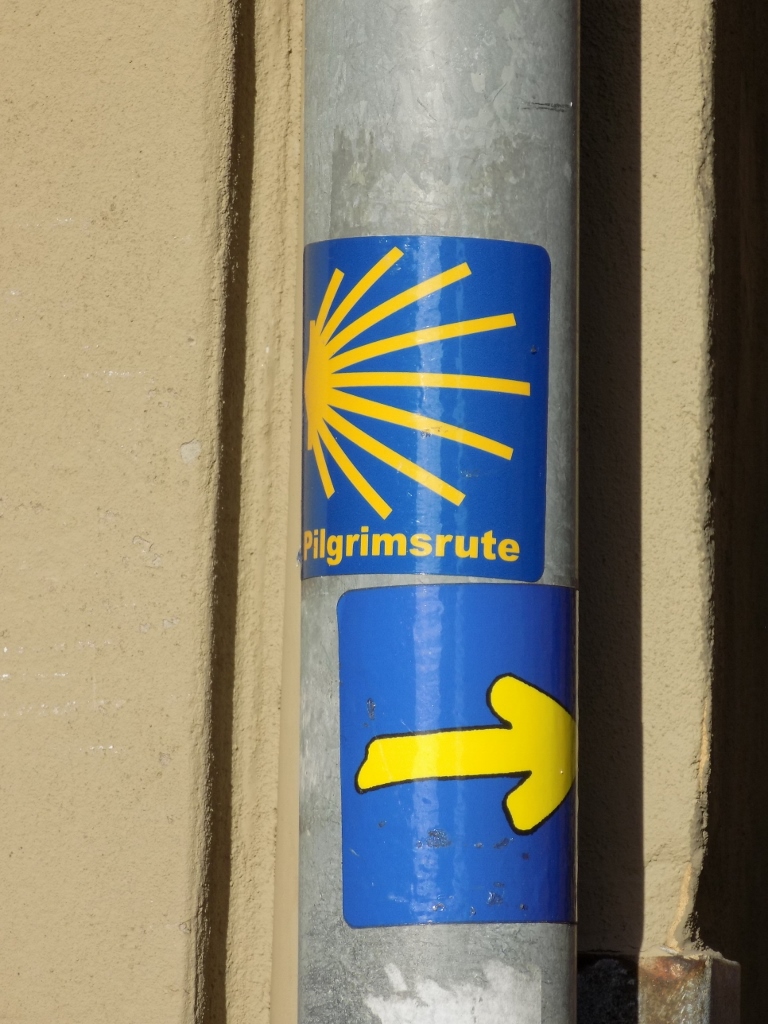 Who wants to walk to Santiago de Compostela, Spain, may also leave from here!
Who wants to walk to Santiago de Compostela, Spain, may also leave from here!
But, the main reason for my coming here was exactly the visit to Kronborg Castle, so let me go back to the story about that.
In the real life, Kronborg Castle was built in the 16th century by Frederick II in the place of a former fortification. Originally the fortification, later the castle, it is located on a protruding part of the shore which is the perfect strategic point for monitoring the seafaring events on such an important maritime route as is the strait that connects the Baltic Sea and the North Sea. Not only is it a good and important place from the military point of view, but already in the 15th century, a Danish king, Eric of Pomerania, also introduced a special passage tax which made it fabulous in economic terms. In this way, Helsingør gained in its significance and also became economically quite strong. So much so that it used to be a serious competition to Copenhagen. With time this economic boom slowed down and actually stopped when that tax for the passage through the narrow strait (the Sound Dues) was abolished in 1857. Still, even today Helsingør is a very important port with numerous ferry connections with the nearby Sweden. The strait that separates these two countries is around 4 km wide at this point.
However, in the unreal life, i.e., in the world of fiction, Helsingør is unquestionably most famous for its literary counterpart, Elsinore castle, and its most famous resident – Hamlet. Thus, in fact, Kronborg is “Hamlet’s” castle and all those gloomy and depressive contemplations of this prince, his discourse with the skill, apparitions of ghosts, etc., all of this was taking place right here.
By the way, it is important to say that Kronborg Castle is often used as the place in which Shakespeare’s Hamlet is shown “on location.” The play was staged here for the first time in 1816, but the international acting stars have realised the importance of such an experience, as well as of their personal marketing, since 1937 when Laurence Olivier and Vivien Leigh played here. He was, of course, Hamlet and she was, of course, Ophelia.
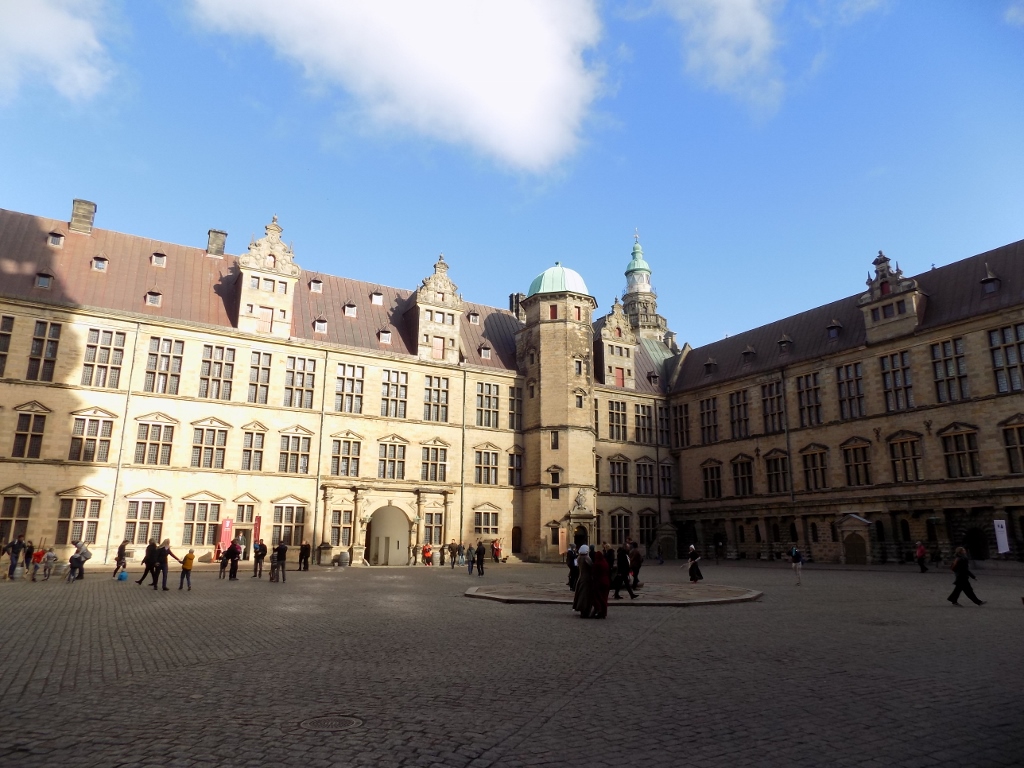 The inner courtyard of Kronborg Castle
The inner courtyard of Kronborg Castle
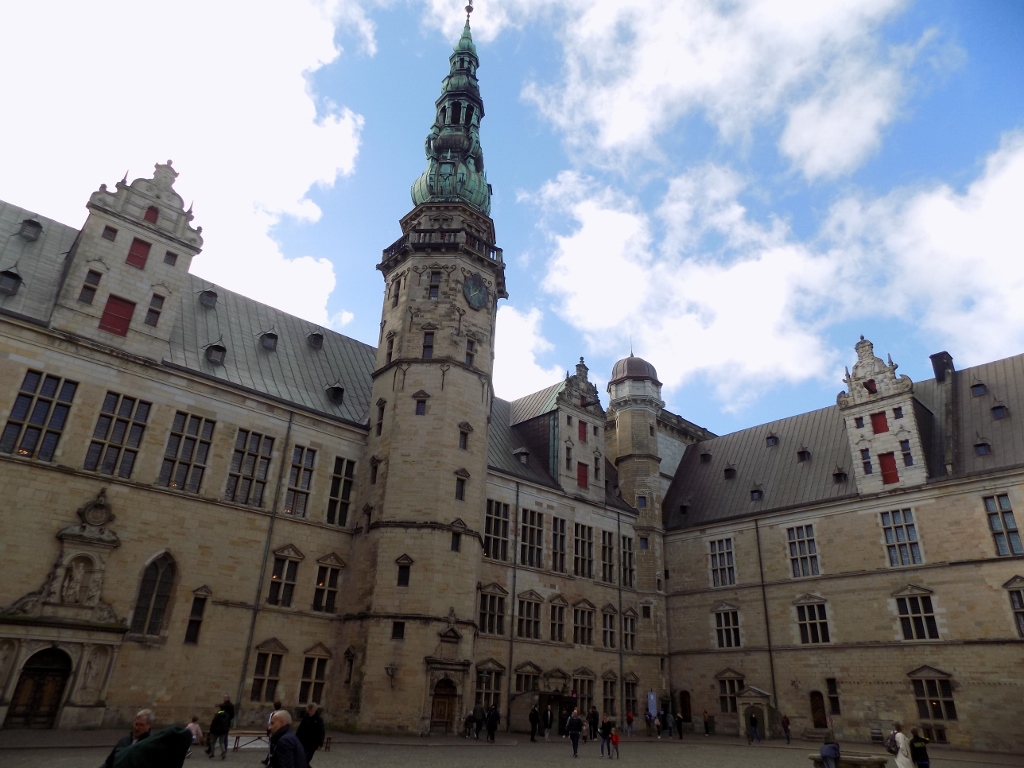 The inner courtyard of Kronborg Castle
The inner courtyard of Kronborg Castle
Thus, I went from the railway station straight to the castle and visited it nicely. It is not a big castle, at least the part that is foreseen for the tourist visits, but it is nonetheless an interesting place to see. There is not much I can tell you about it now, but here are a few photos from the interior of the castle.
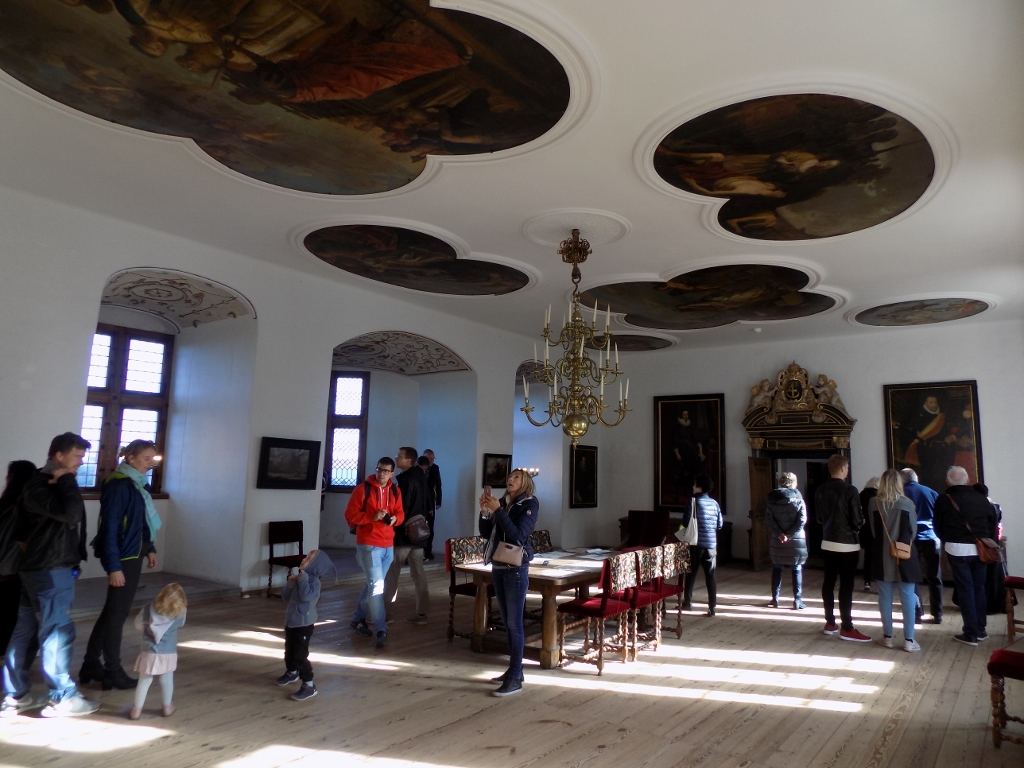 A detail from Kronborg Castle
A detail from Kronborg Castle
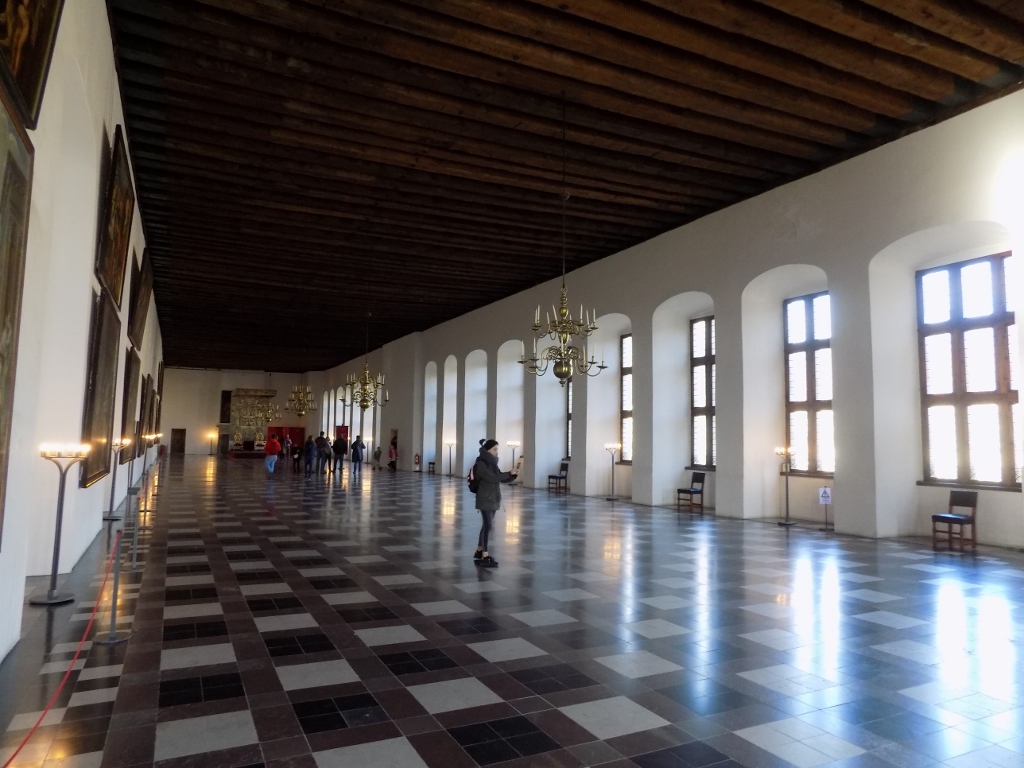 A detail from Kronborg Castle
A detail from Kronborg Castle
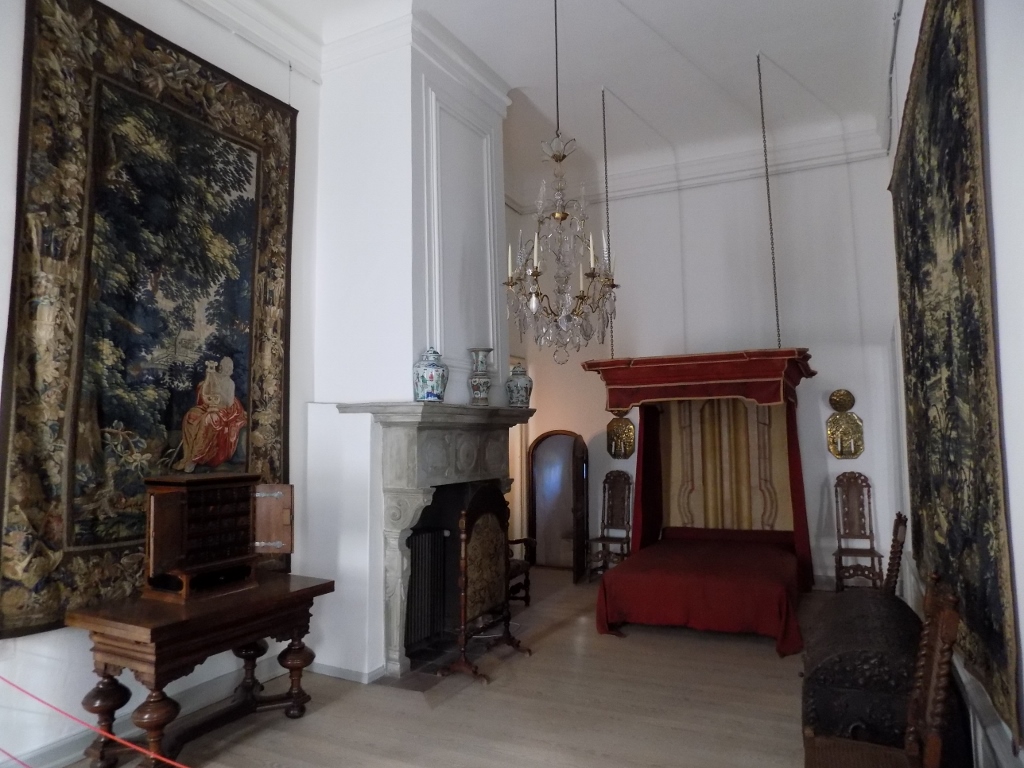 A detail from Kronborg Castle
A detail from Kronborg Castle
On the part of the fortification that faces the narrow strait and Sweden, there are old cannons on display.
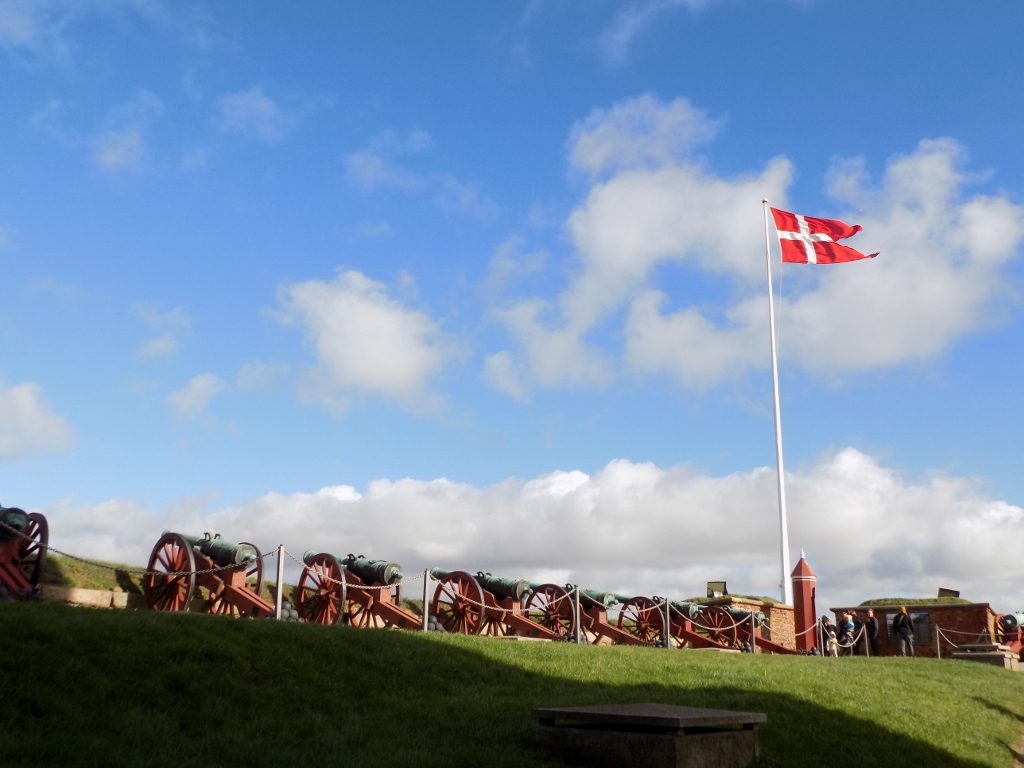 Cannons on the ramparts of Kronborg Castle
Cannons on the ramparts of Kronborg Castle
On the other hand, there are a lot of people employed at the castle, from small children to people at an advanced age, and they are all dressed in period costumes and play some of “role” of theirs, which makes one get an impression of having entered some old times.
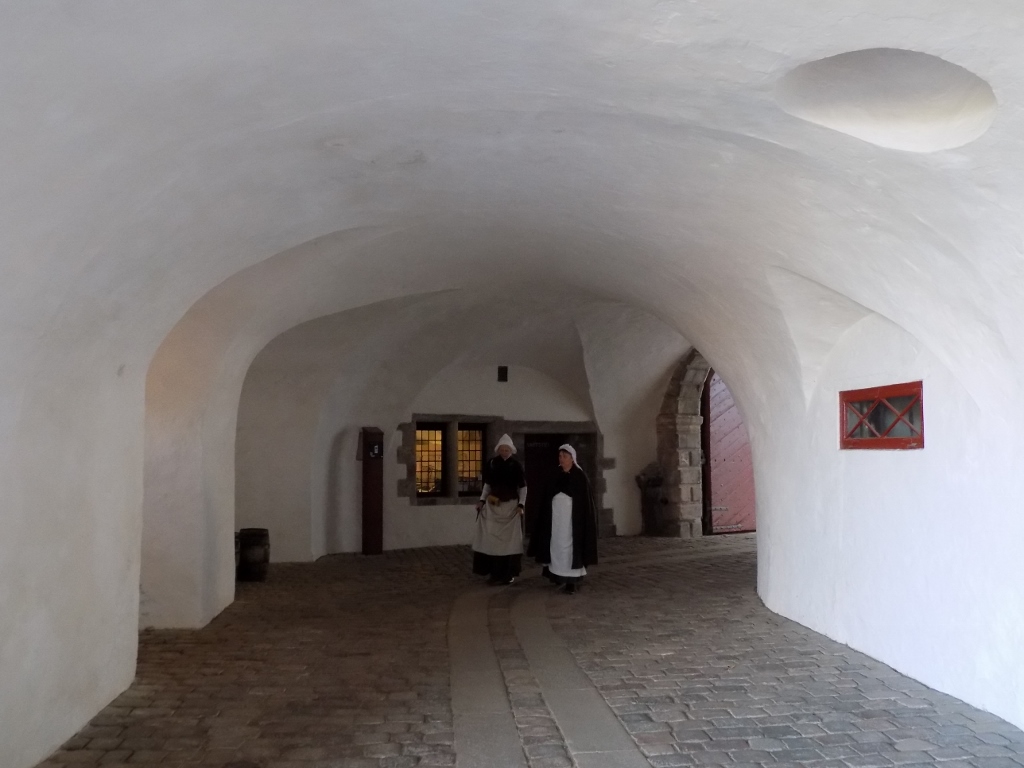 Two “servant girls” working at Kronborg Castle
Two “servant girls” working at Kronborg Castle
When I finished with the visit to the castle and headed towards the exit, I made a brief stop by the “medieval” fair that was organised along the wet moat. The stalls offered different souvenirs on sale, as well as food. There was also entertainment organised for the visitors, including a costumed procession.
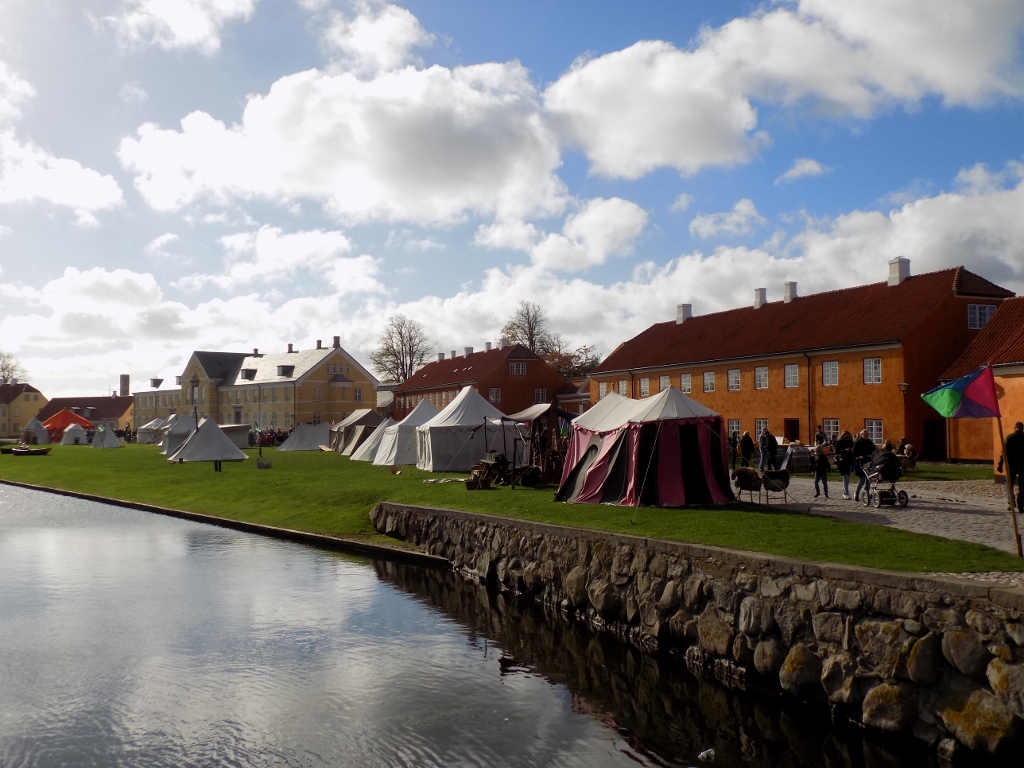 Medieval fair by the wet moat
Medieval fair by the wet moat
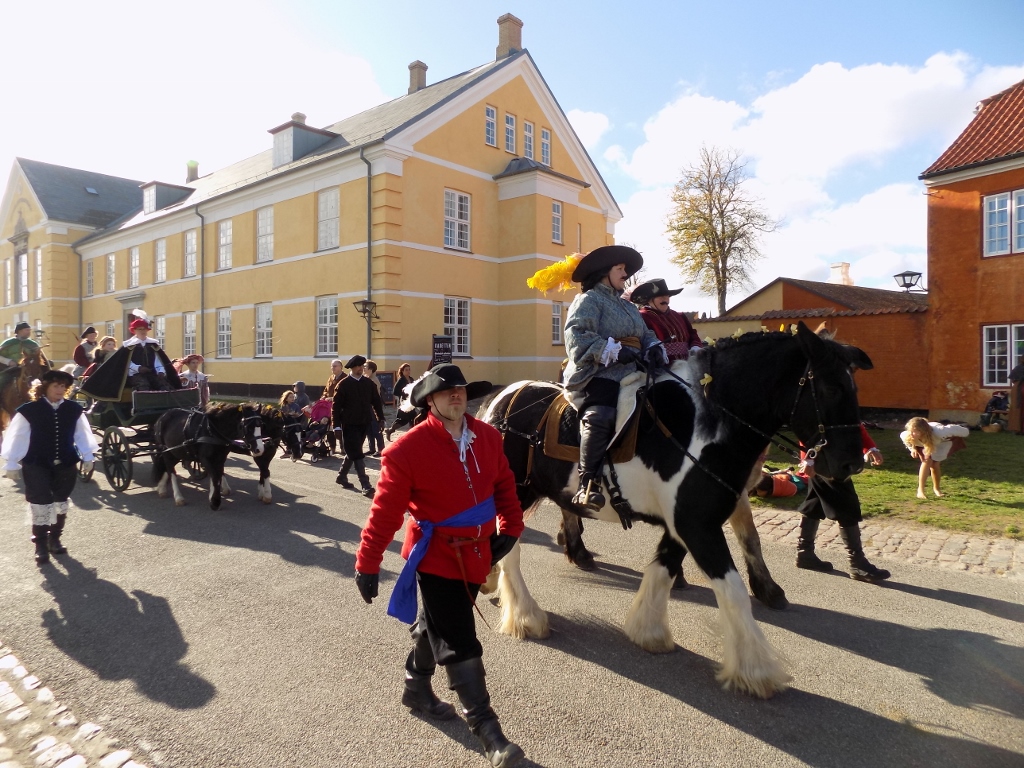 Costumed procession
Costumed procession
Since I planned to visit another castle that was half an hour away by train, I went towards the railway station, but I also wanted to walk a little around Helsingør itself first. Thus I saw from the outside St Olaf’s Church, which is in fact the cathedral of the local diocese, and then I walked to Carmelite monastery.
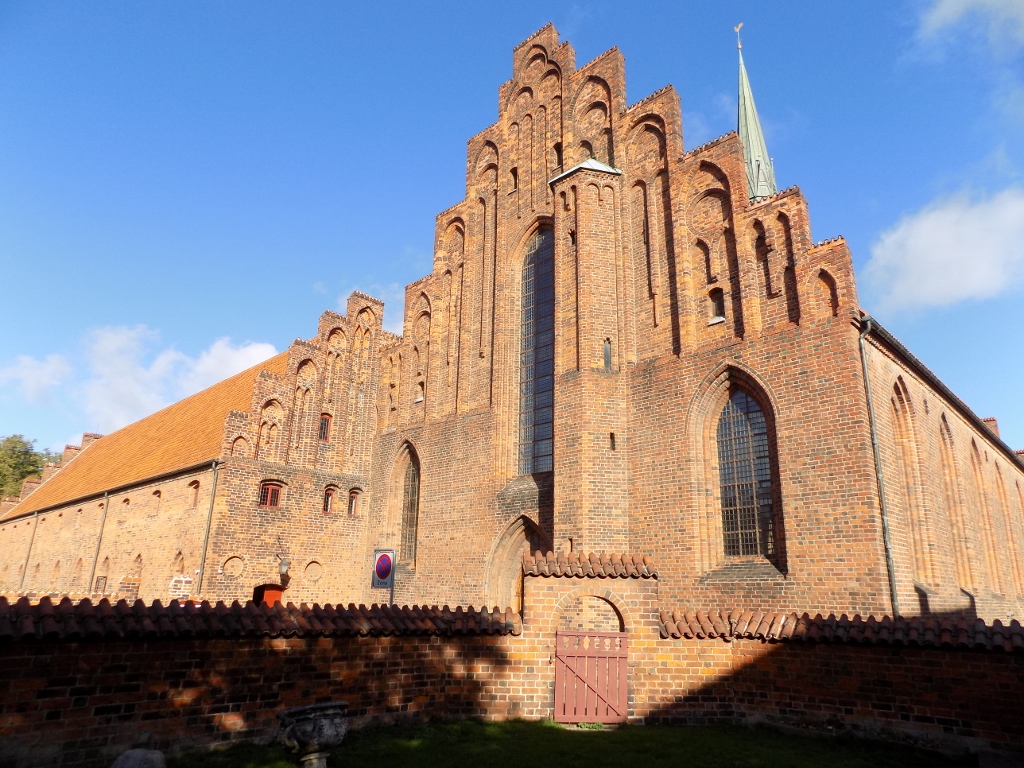 Carmelite monastery and St Mary’s Church
Carmelite monastery and St Mary’s Church
Without any plan or intention to do any sightseeing, I was delighted again when I saw a sticker here that referred to the pilgrimage along the Way of St James. I also saw an open door there and went in, following the cloister around the inner courtyard. Then I came across a gentleman who was taking two Danes on a visiting tour. They were right near a room, so since I saw him unlocking the door I asked him if I could come in as well. He said I could and then he started to guide the tour in English.
We slowly went around the monastery and it was all very interesting. The monastery was founded in 1430, but during the Reformation, in 1536, the monks were kicked out and the monastery was abandoned for a while. After some time, it was turned into a hospital for the elderly and the poor, while in one of its wings there was a grammar school.
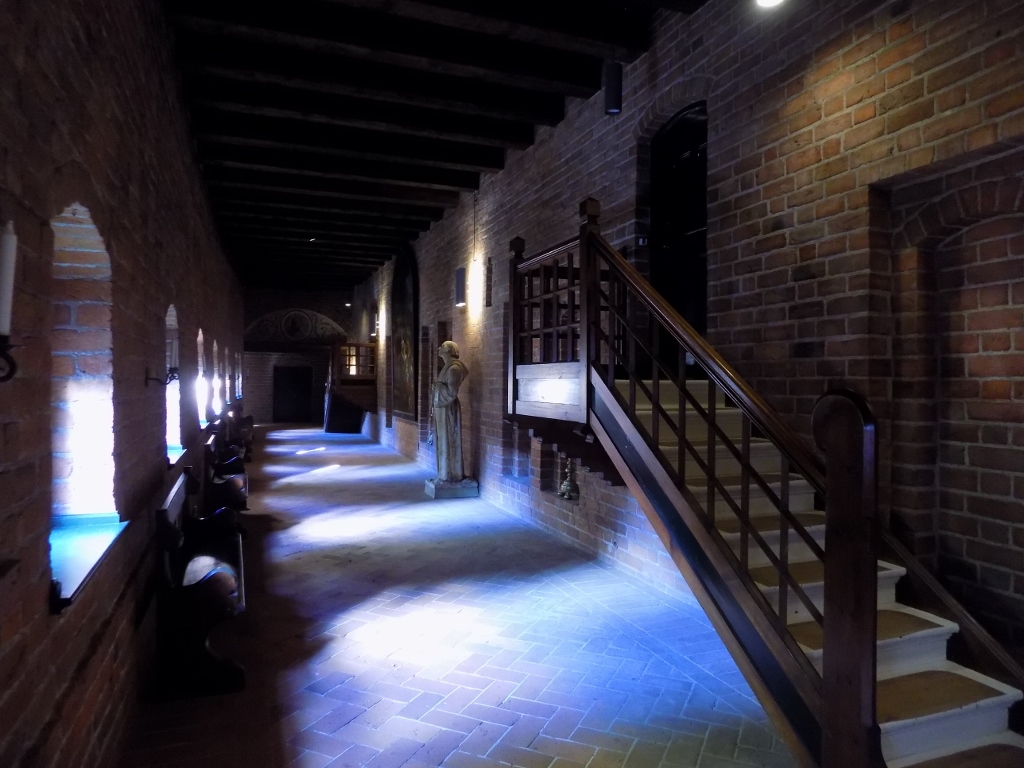 A hallway at Carmelite monastery
A hallway at Carmelite monastery
It was only at the end of the 20th century that the local church and the diocese took over the monastery which was in the meantime partially restored.
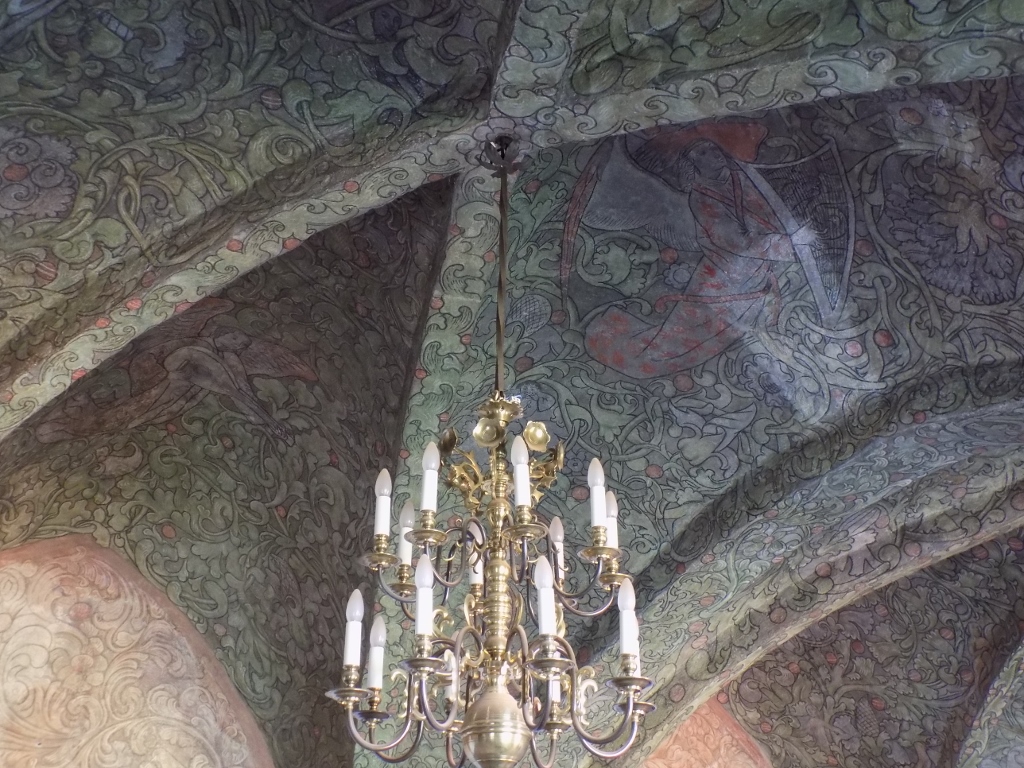 Wall paintings at Carmelite monastery
Wall paintings at Carmelite monastery
During the tour I heard some very interesting stories, one of which referred to the elderly and wealthy women who remained alone at their advanced age and from 1930 they had a possibility to be placed in one part of the monastery. Each one of these women had her own “room” and when at some point they wanted them to move out to some other place, they protested and refused. The last one passed away in 1985.
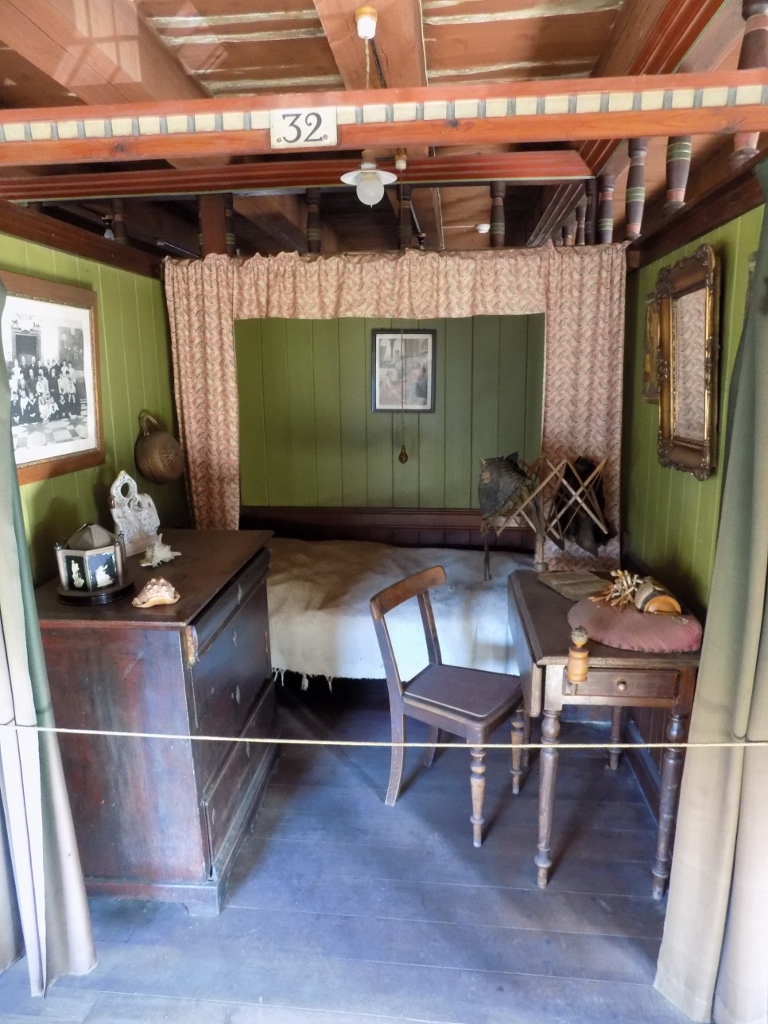 Room no. 32
Room no. 32
And then we entered the church which left me breathless. It is a very beautiful church which shared the destiny of the monastery it belongs to, so it was even out of use for a while, but then it was used for the masses in German since there were a lot of people in the city who spoke German (mostly because of the trade, but also because at some point German was the “official” language in the army).
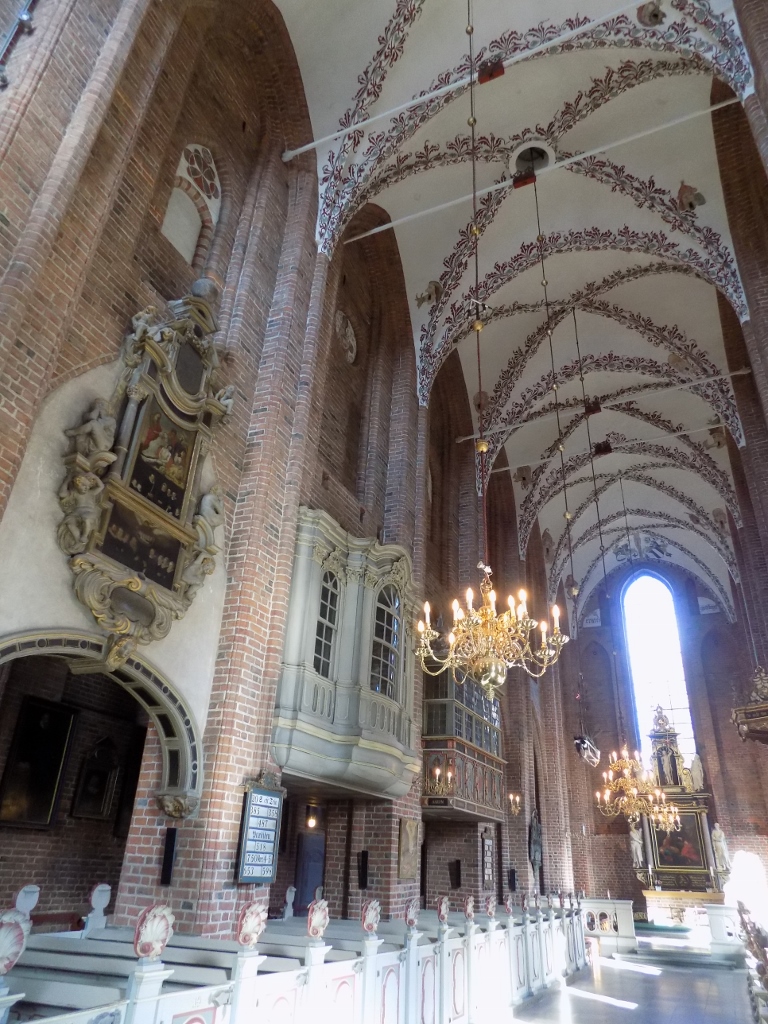 St Mary’s Church
St Mary’s Church
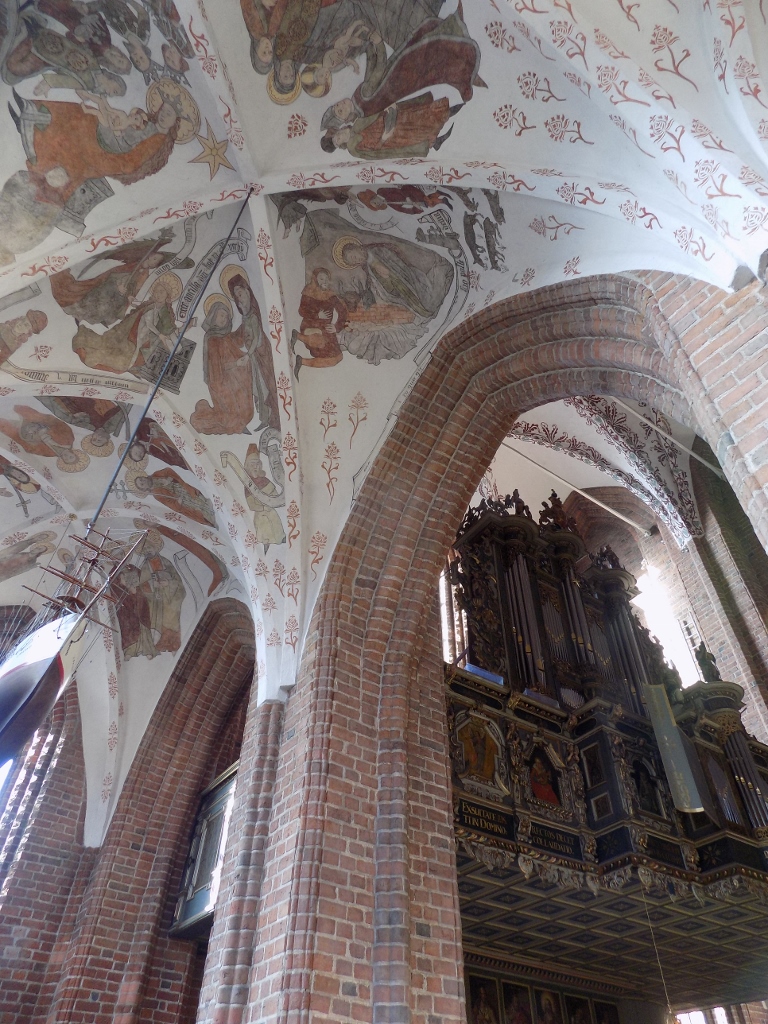 St Mary’s Church
St Mary’s Church
Again I heard a lot of interesting stories, but perhaps the most amusing one was that the author of the wall paintings was evidently a local artist. How can one tell? Well, by the dish that was in his vision offered at the Last Supper – a wild boar. Regardless of whether this was a domestic pig or a wild boar, it would certainly not be a part of a Jewish meal.
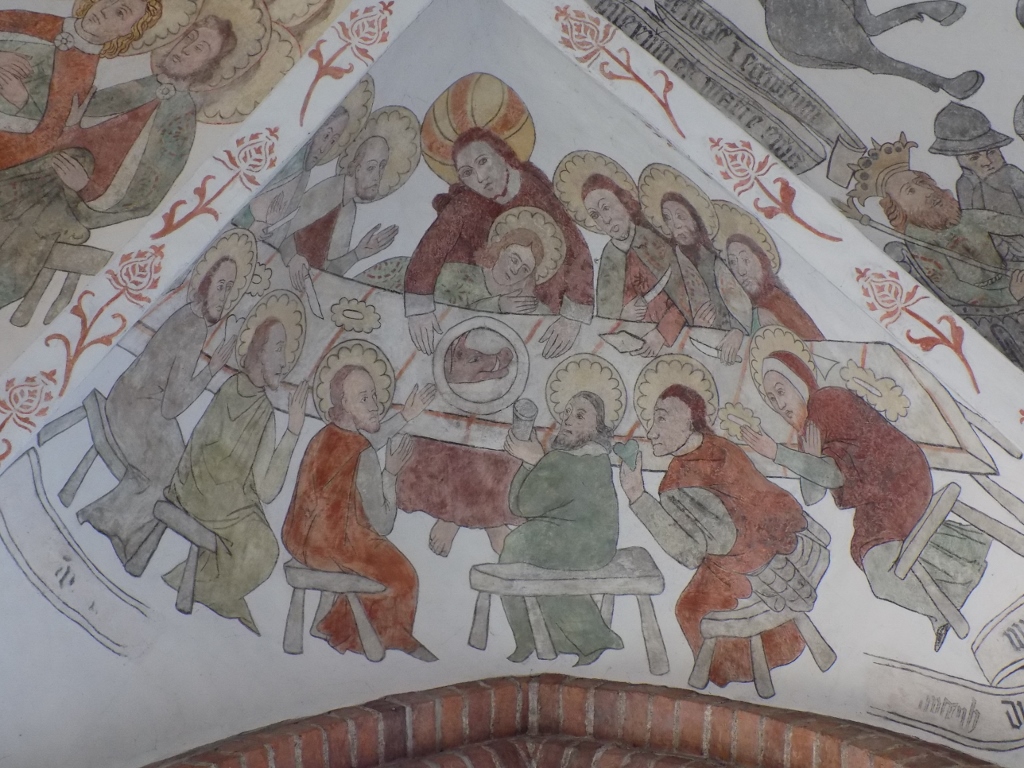 The Last Supper in the version of a fresco painter from St Mary’s Church
The Last Supper in the version of a fresco painter from St Mary’s Church
When I finished with the visit to the monastery and the church, I went to the railway station and there I caught a local train to Hillerød. I was supposed to visit yet another castle this day, but first I had to find it.
There was one thing in Denmark that I found quite interesting. It is not all covered in information of interest for tourists. Thus, for instance, I arrived in Hillerød and there I could not see any sign that would show the direction in which Frederiksborg Castle (Frederiksborg Slot) was. I would expect large letters and even bigger posters that advertise something that is important for the visitors to this town. I could not even see a map that could help me find my way around. So, I used an old recipe – ask the locals. But, it seemed that in this town the locals were not much interested in tourist attractions either. One girl tried to persuade me that I should take a train to go there (she was actually thinking of Fredensborg Palace), possibly even via Copenhagen (completely senseless). I showed her in my guidebook that I wanted to see a castle precisely in this very town and it was only then that she said she was not local and did not know the place well. But, she was kind. Then I asked another girl if she was from Hillerød, she was not, but was ready to help. We both agreed it would be better to ask the employees working at a shop at the station. And then they told me which way to go.
So, I walked in the shown direction, but then I came across a forking. What now? I asked an elderly lady I saw there, but she had no idea what I was talking about. Then I asked a woman who was working right in the shop that was at that forking and she did know what I meant, but had no idea how to get there. And then finally another woman was passing by and she told me how to get down to the lake (there was still some walking to do to get to the castle), but this did help me a lot. And when I got down to the lake, I was delighted.
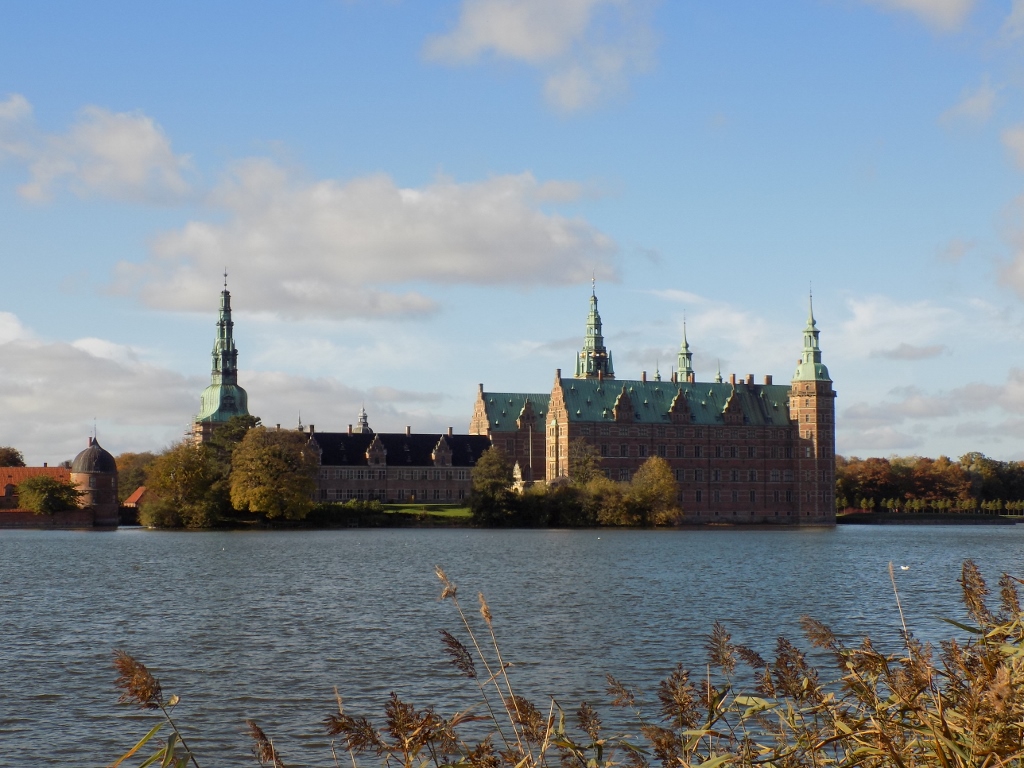 Frederiksborg Castle
Frederiksborg Castle
Frederiksborg Castle spreads over three small islands on a lake. The original castle was built by Frederick II who bought an estate here in 1560 naming it after himself. However, it was his son, Christian IV, whom we have to thank for the major construction. For some hundred years, the castle was the residence of the Danish rulers and they were anointed at its chapel during this period. Later, the rulers used more the relatively nearby Fredensborg Castle, which is even today the official spring and autumn residence of the Danish royal family.
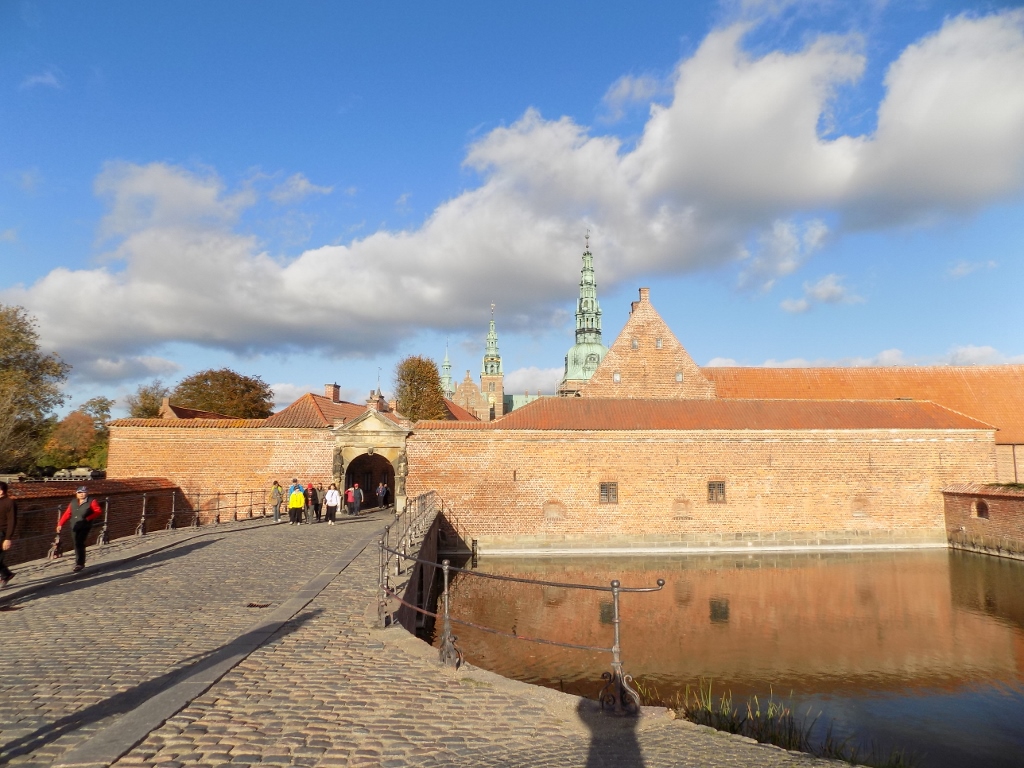 Access to Frederiksborg Castle
Access to Frederiksborg Castle
Getting closer to the entrance into the castle, I was a little worried that it may be closing already at 4 pm, but it turned out it was open until 5 pm and that gave me sufficient time to walk around the castle.
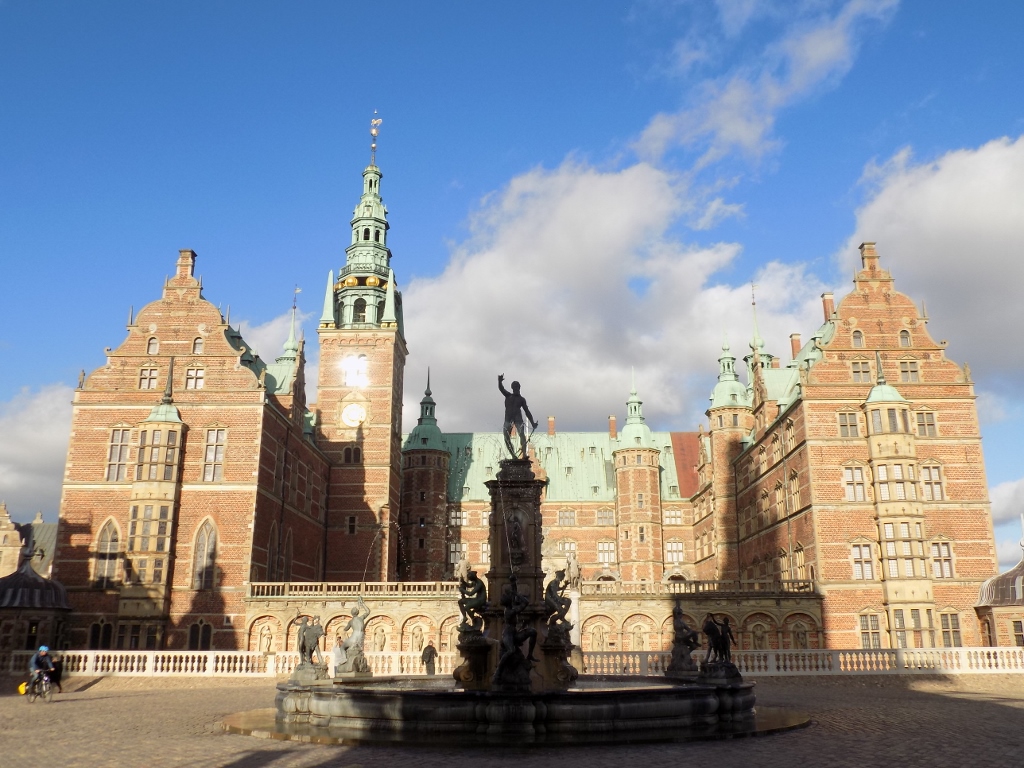 Neptune Fountain in front of Frederiksborg Castle
Neptune Fountain in front of Frederiksborg Castle
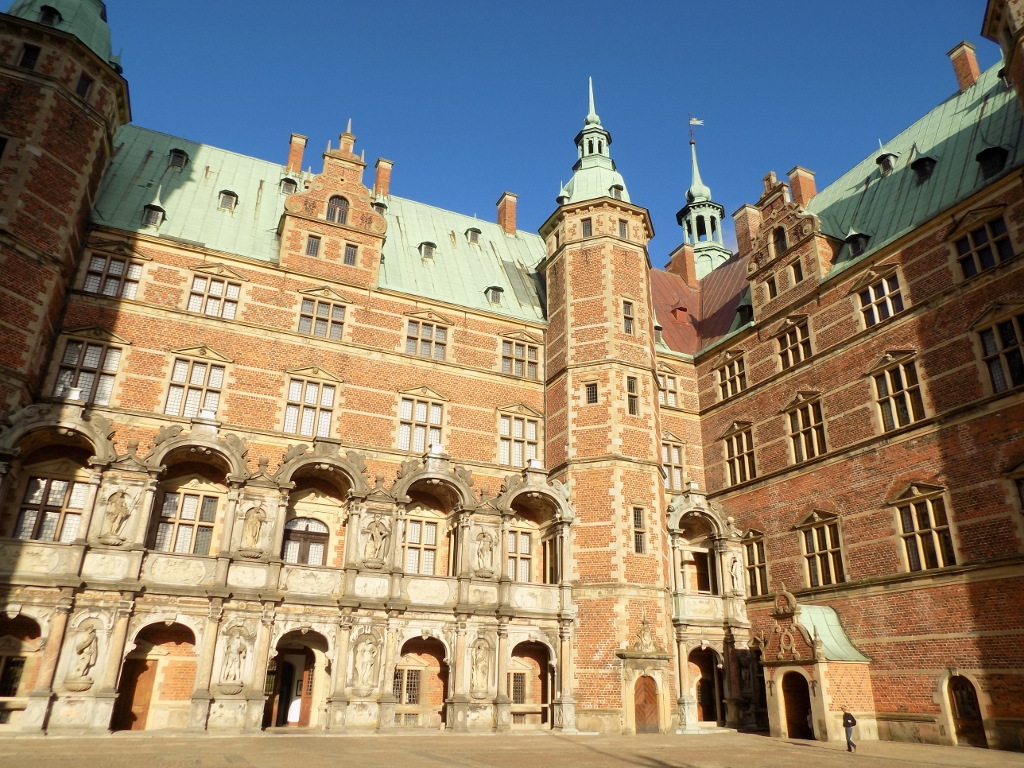 Inner courtyard of Frederiksborg Castle
Inner courtyard of Frederiksborg Castle
Frederiksborg Castle is a truly impressive edifice, but it is still not a problem to visit it relatively quickly. It contains really a lot of paintings of different members of the royal dynasties and aristocracy, but since this meant nothing to me, I did not hang around and study a whole myriad of portraits, but rather I only made an occasional stop and read a few pieces of information here and there.
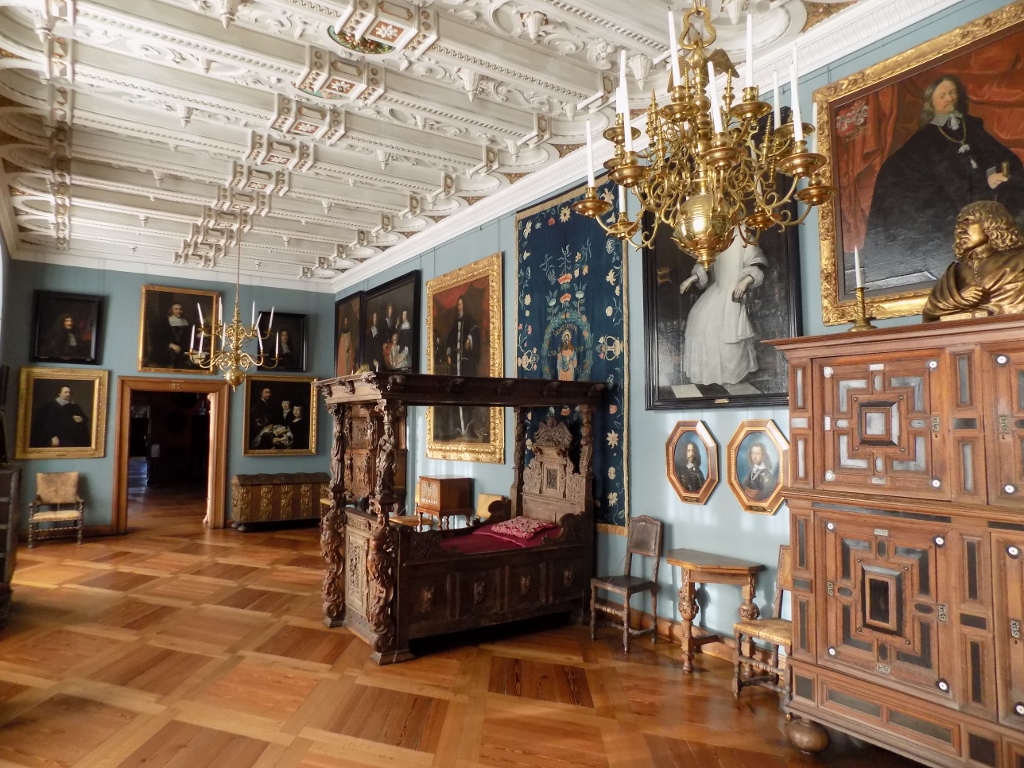 A detail from the interior of Frederiksborg Castle
A detail from the interior of Frederiksborg Castle
One of the first larger and important rooms one comes across is the Chapel and it was decorated quite heavily, although this is not irritating. Here I came across a couple of employees whose job was to walk around the castle in historic costumes and pose for the visitors.
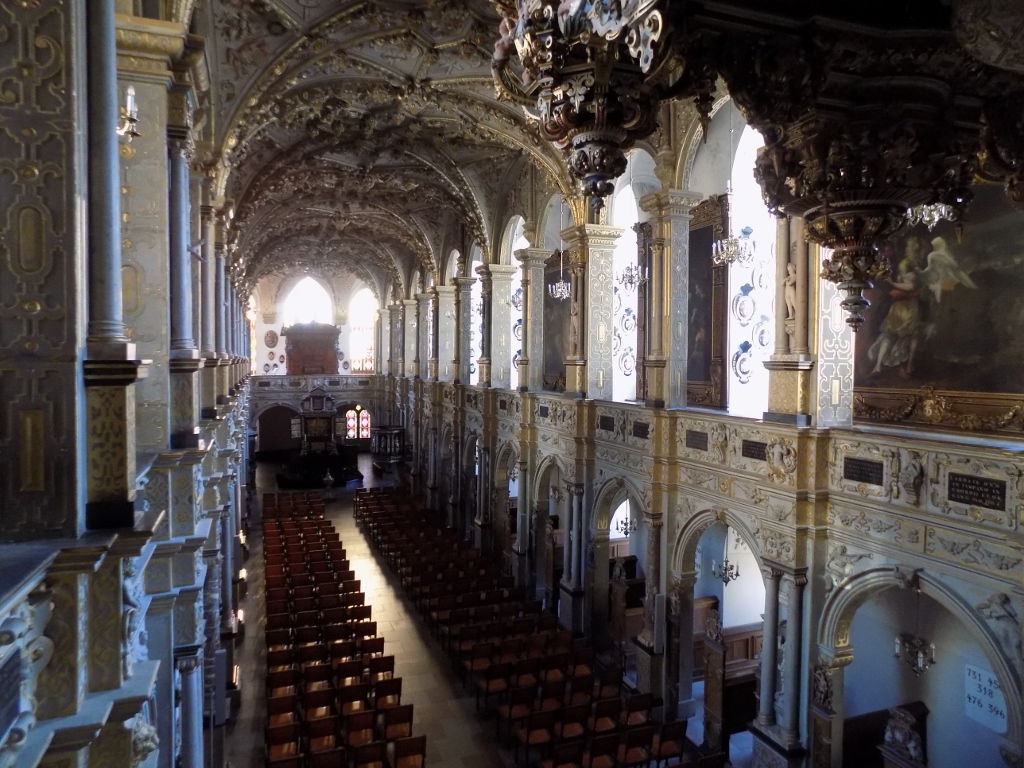 The Chapel
The Chapel
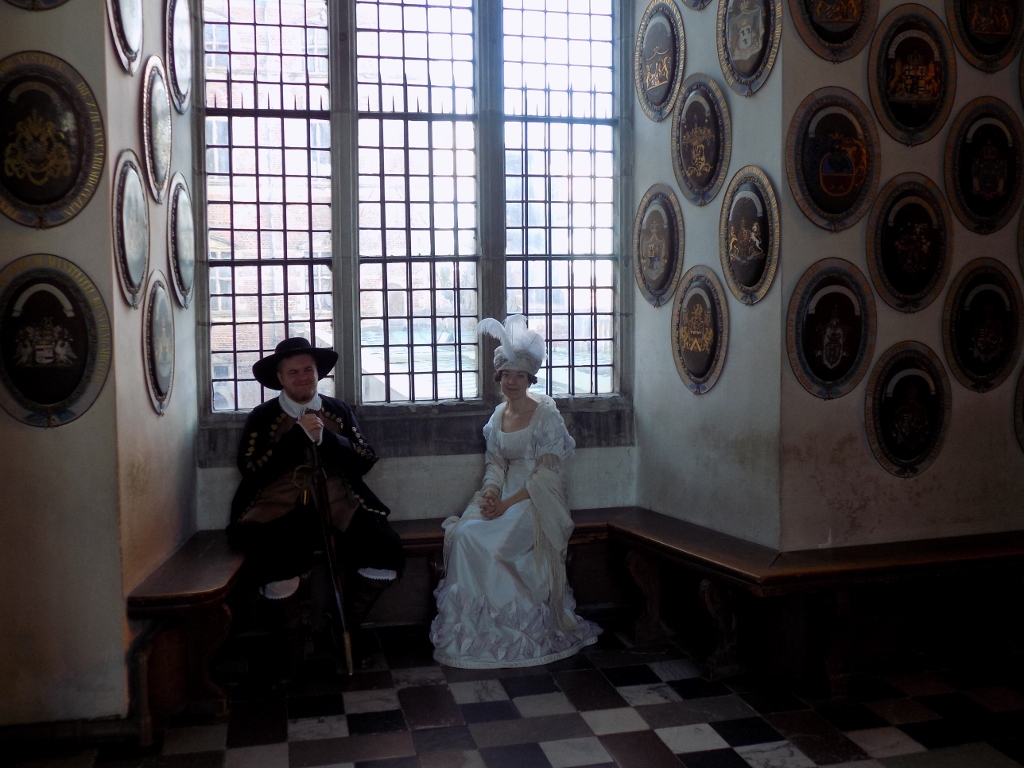 Employees posing for the visitors
Employees posing for the visitors
There are numerous coats-of-arms displayed on the walls of the chapel and I presume the Danish royal family has gotten them from their contacts around the world. I found it interesting when at some point I noticed right in front of me one that somehow seemed familiar. I looked at it a little better, recognised its heraldic and I could see that this was the coat-of-arms of the Karadjordjevic dynasty and the Kingdom of Yugoslavia, around which there was the name of Prince Paul who was the Regent of Yugoslavia.
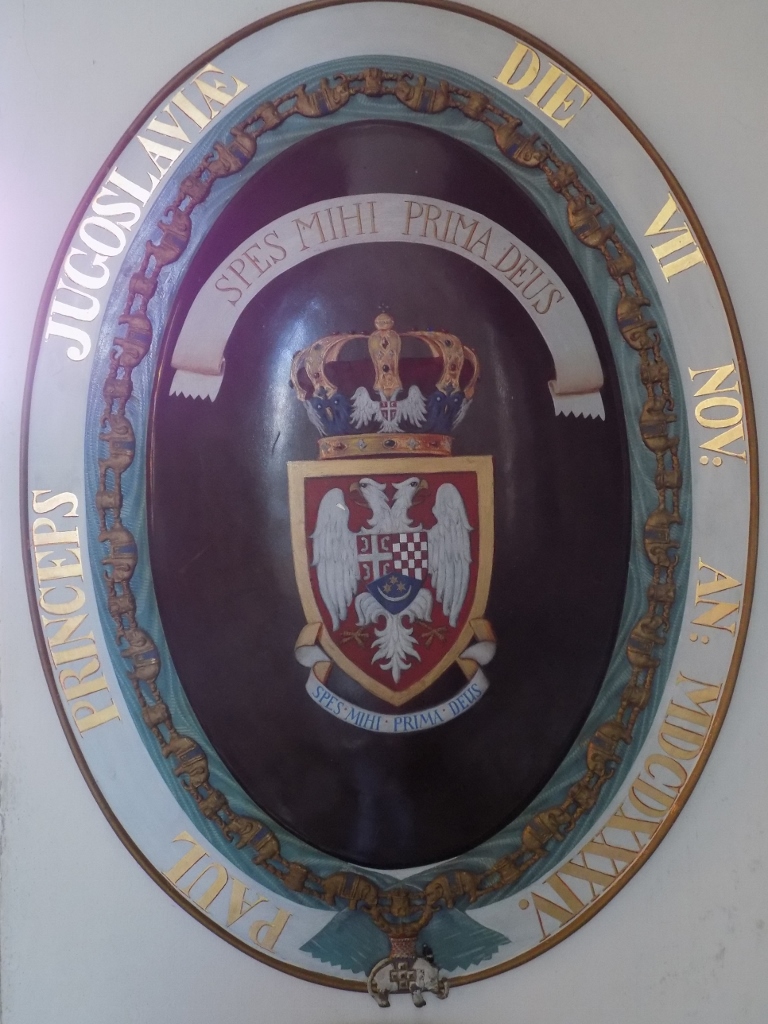 The dynastic coat-of-arms of the Kingdom of Yugoslavia
The dynastic coat-of-arms of the Kingdom of Yugoslavia
While I was still walking around the castle, I noticed through the windows a stunning park that spreads on the other side of the lake, so after I finished the visit to the castle I went to its “back” part and walked there for a while.
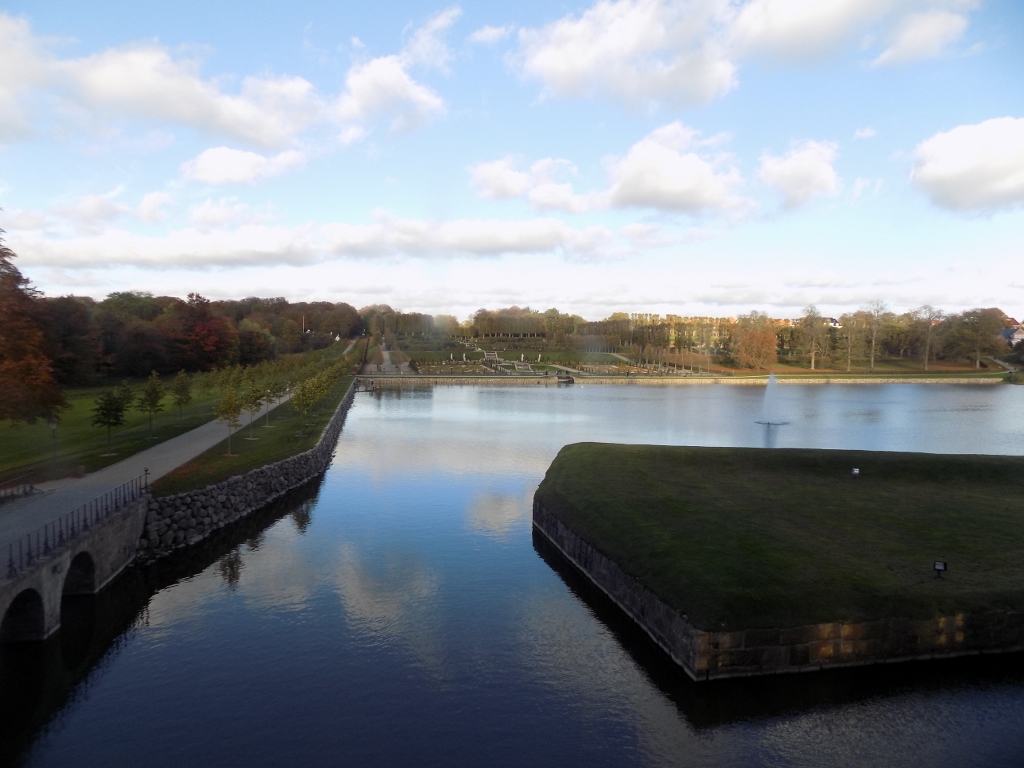 View at the lake and the large park from the castle
View at the lake and the large park from the castle
The park includes several lakes and ponds, beautiful landscapes, as well as a Baroque Garden made there at the beginning of the 18th century.
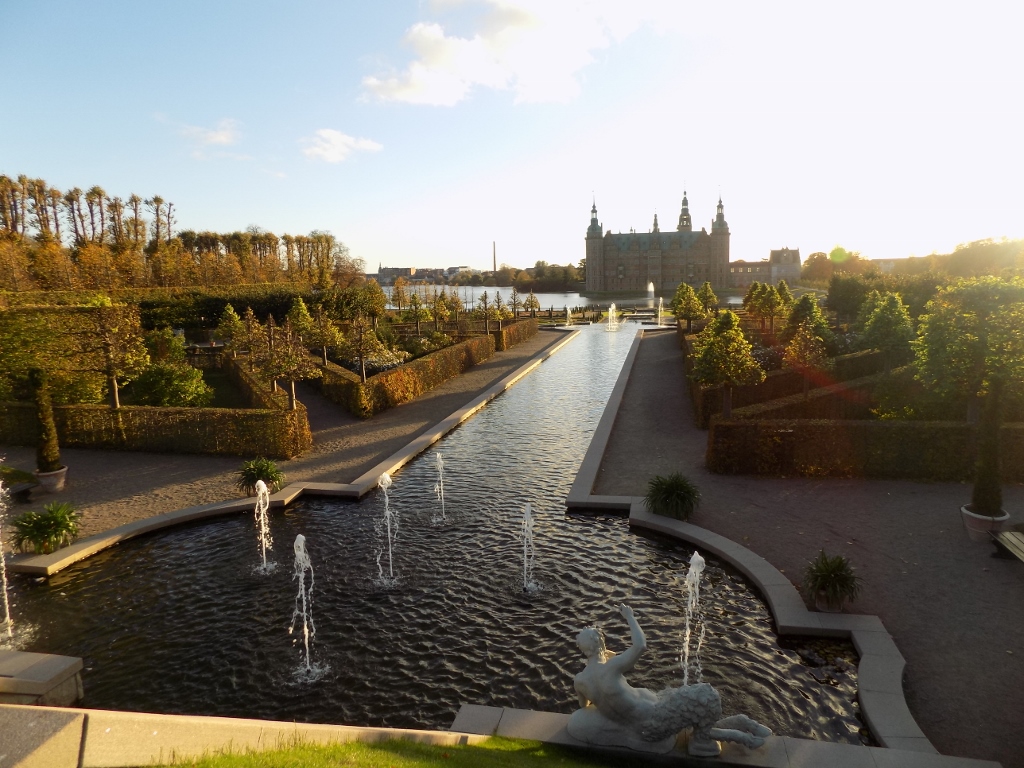 Baroque Garden and Frederiksborg Castle in the background
Baroque Garden and Frederiksborg Castle in the background
The day was perfect. Not only the weather was fantastic, even the rather strong and powerful wind that was constantly present in Helsingør stopped blowing here, but also everything I visited and saw on this day was great.
As I went back to the centre and the walking area in Hillerød (by this time I knew my way around well), I realised I was hungry, so I sat at a restaurant, had a nice dinner there and then I returned to Copenhagen.
The next day I went again to peninsula Jutland, which involved a comparatively long coach drive, but I did not mind it in the least. Admittedly, I wondered if I had made a mistake by selecting my destination of the day, but the ticket had already been bought and that settled the matter. Basically I was just going to visit a village. Just that. Still, that village is rather important in its category, so much so that it is on the UNESCO’s World Heritage List.
I’m talking about Christiansfeld, a settlement that was founded in the 18th century, in 1773 to be more precise, by members of the Moravian Church, which is one of the Protestant churches. Christiansfeld is one of the best preserved settlements founded by members of this Church. It spreads around the central Church Square and is oriented along two tangential east-west streets that start precisely from this square.
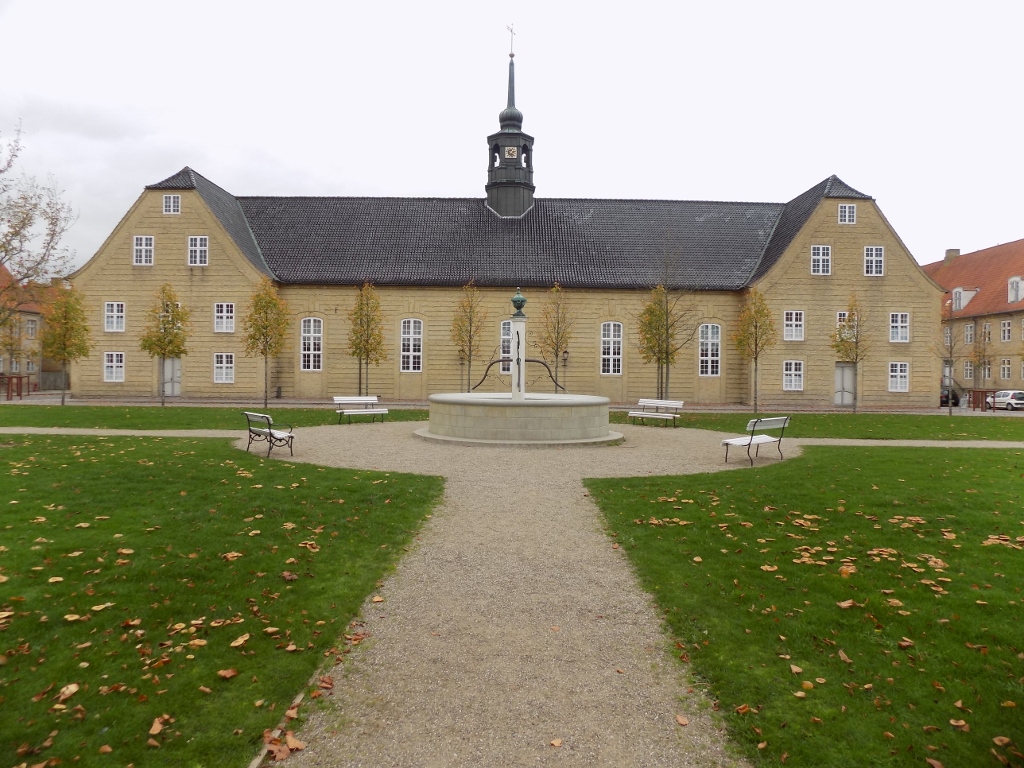 Church hall, i.e., the Moravian Church
Church hall, i.e., the Moravian Church
The settlement reflects the social and ethical ideals of the Moravian Church. It is precisely the Christian faith of the Moravian Church that constitutes the backbone of the urban planning, architecture and daily life. Among other things, the social structure of the Moravian Church also includes large communal houses for the congregation’s widows and unmarried men and women. The houses are typically made of yellow bricks with red tile roofs.
I started my sightseeing right from the central square which in its ground plan has a cross and which also has numerous linden trees, as well as a fountain in the centre. I first went into the church to see what it looked like on the inside. Very simple and without a large number of ornaments, just like the entire architecture of the place. The Church Hall, which is the official name of the village’s church, was built in 1776.
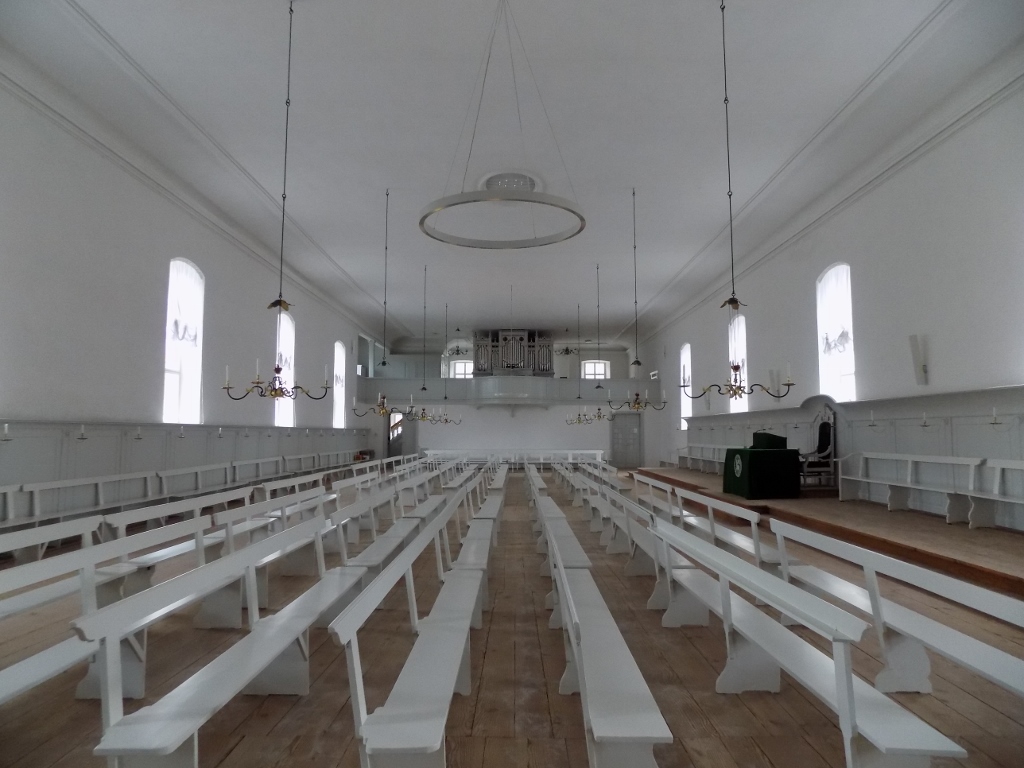 Interior of the Church Hall
Interior of the Church Hall
Around the central square there are also the most important houses in the village. To start with, there is the first house that was built in Christiansfeld on 1 April 1773, which is nicely displayed on it.
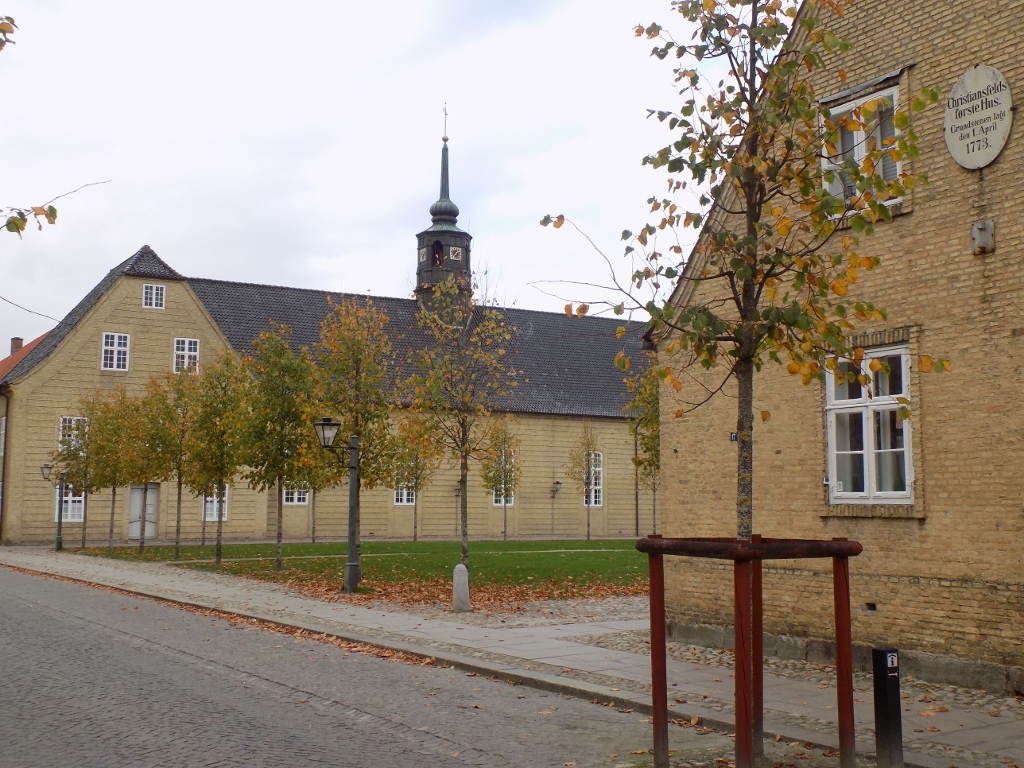 The Church Hall with the first house in Christiansfeld across the square
The Church Hall with the first house in Christiansfeld across the square
On one side of the square, there is a house that was built at the very beginning for the local vicar who was also one of the founders of the settlement and the house was named after him.
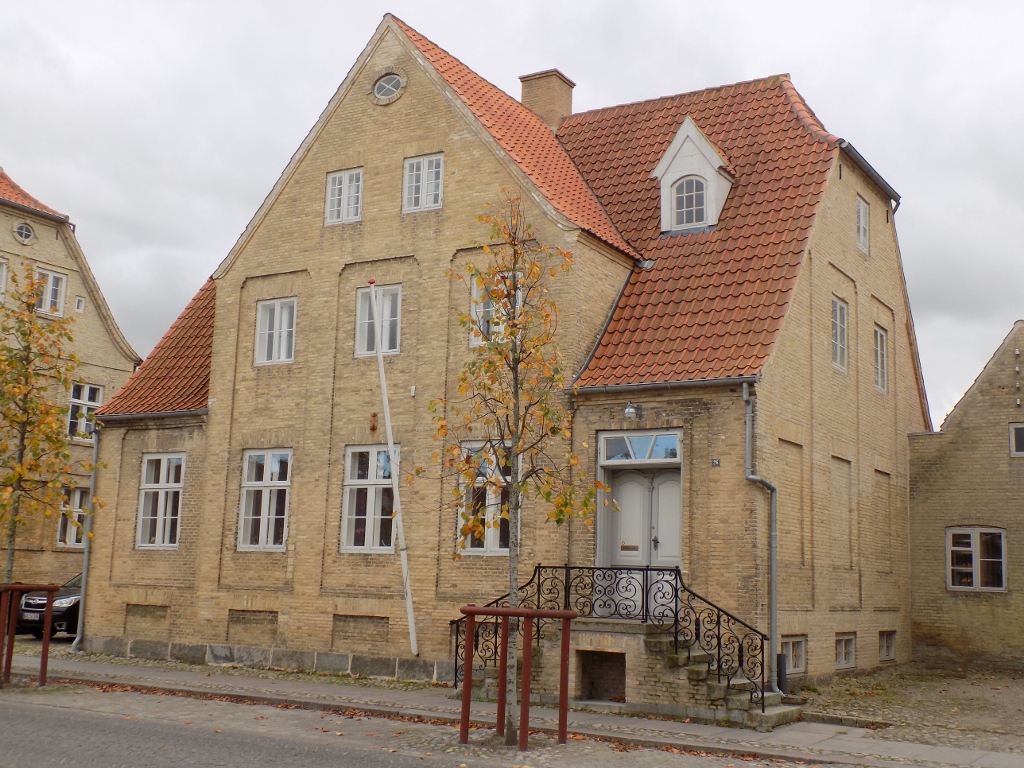 Briant’s House
Briant’s House
And finally, there is also the Sisters’ House at the square in which unmarried women and girls lived from 1776. Nowadays, it contains a museum, a cultural centre, as well as a tourist information office.
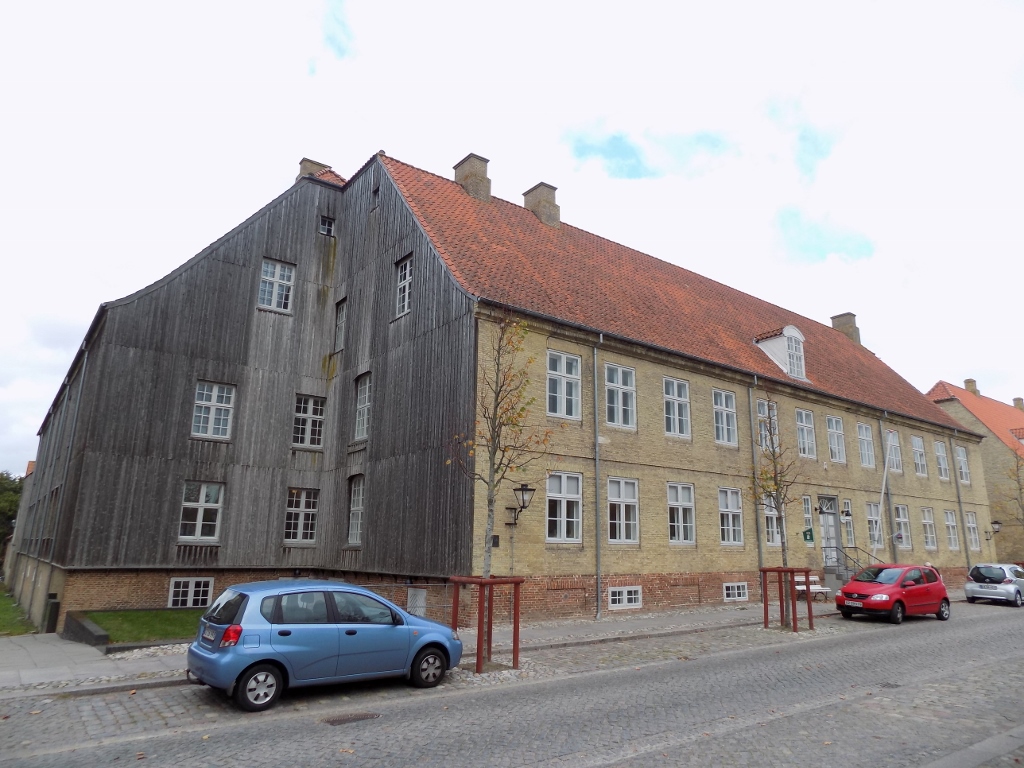 Sisters’ House
Sisters’ House
In addition to its urban-planning solutions, Christiansfeld is also famous for its honey cakes and there is a bakery that has been producing this type of cookies since around 1800. I can report that their cookies, cakes and chocolate are great, although the coffee was far from spectacular. Well, they are not famous for their coffee anyway (and I doubt they ever will be).
Along the perimeter of the village, there is also a very specific local cemetery. It was founded in 1774. At the time when I visited it, there were some works going on, but what is important is that all the tombs have been kept. All the graves are identical and equal by their size, but it is interesting that the “Brothers” (this is the term used in the brochure to denominate men) are buried facing west, while the “Sisters” are buried facing east. In the English-language brochure it literally says that they face these points of compass. I guess it is not very important and certainly not worth any verification, but I presume that this marks the position of the bodies if they were pulled up, rather than that they bury them “standing.”
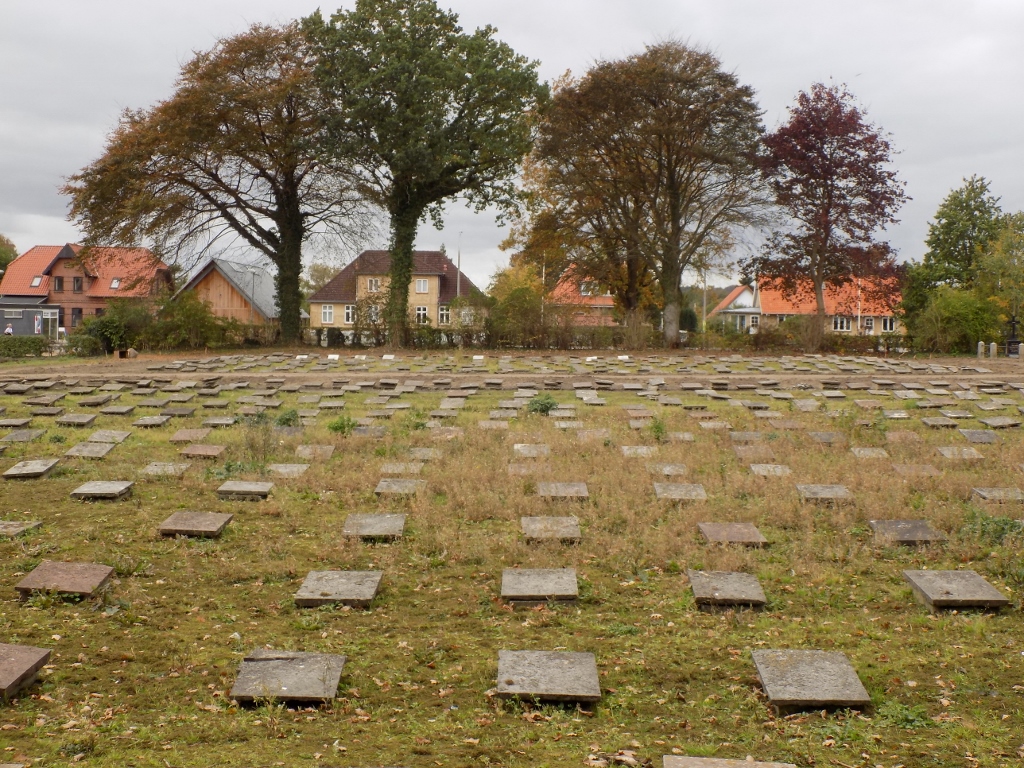 Cemetery in Christiansfeld
Cemetery in Christiansfeld
So, as I’ve said, before coming here I was a little worried about the choice of my destination, but already during the visit itself I was very pleased with what I was seeing. The village is a little unusual and not widely popular among visitors, but this does not make the visit any less interesting and worthwhile.
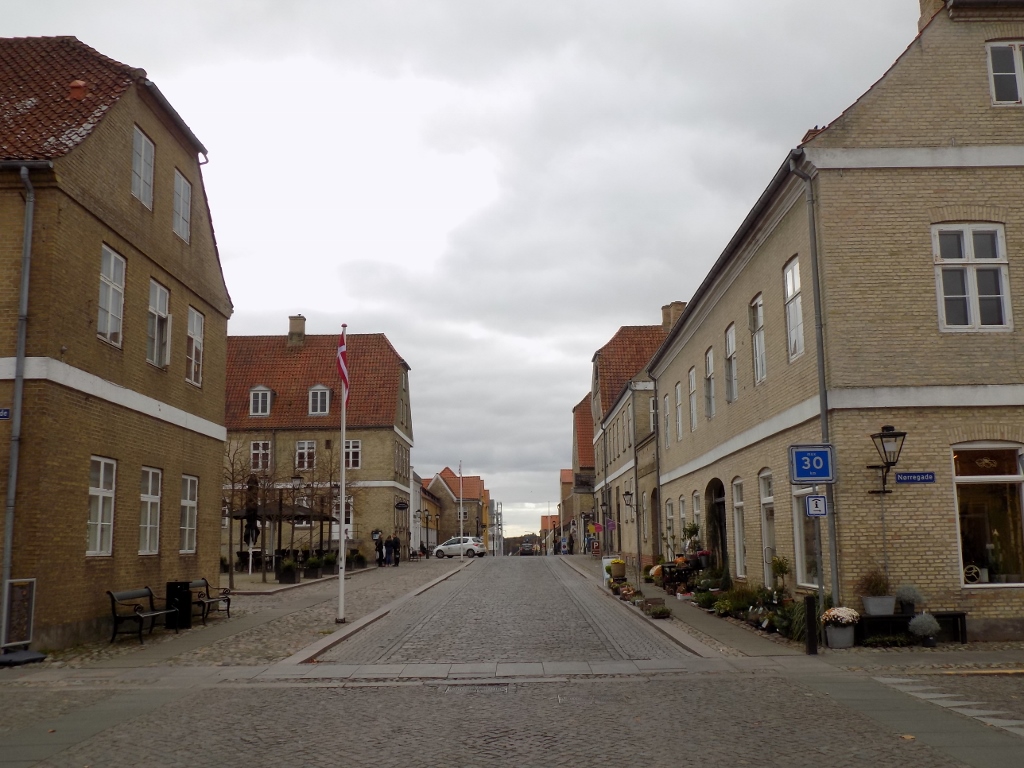 Main street in Christiansfeld
Main street in Christiansfeld